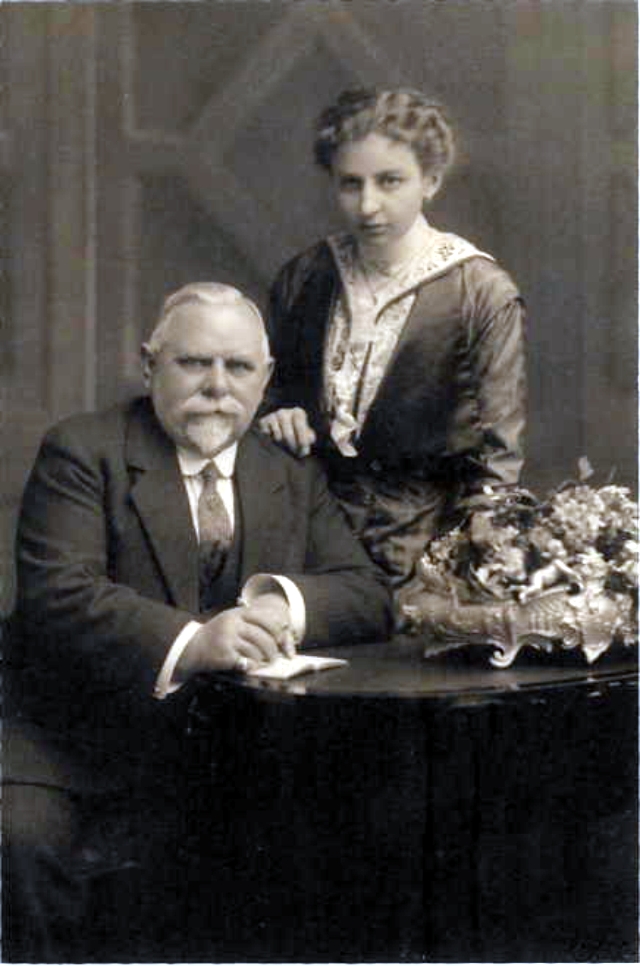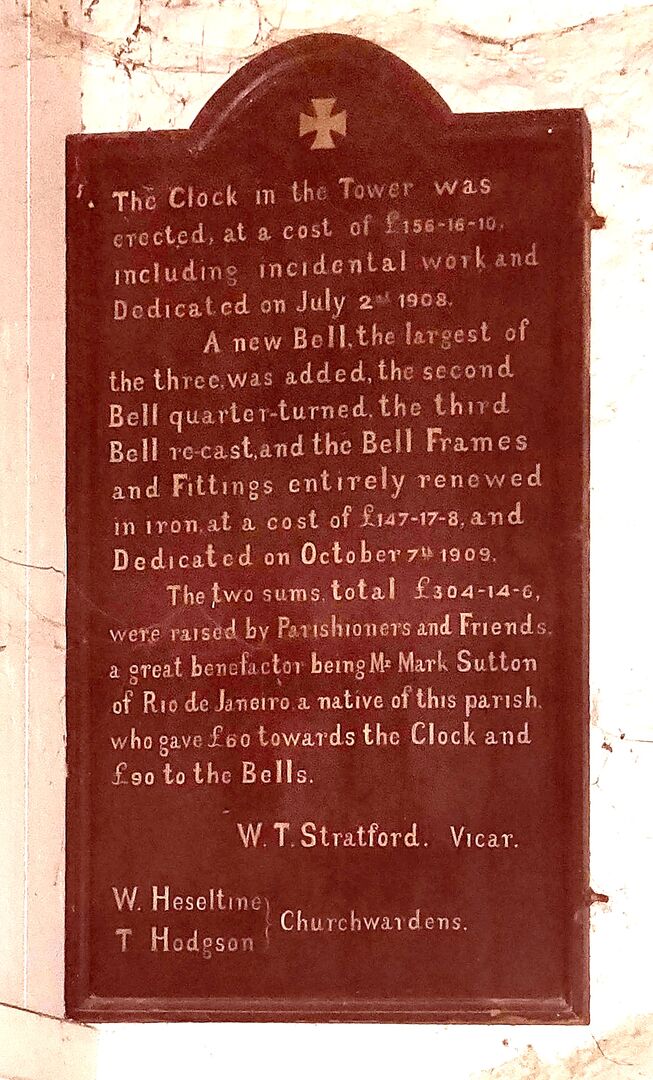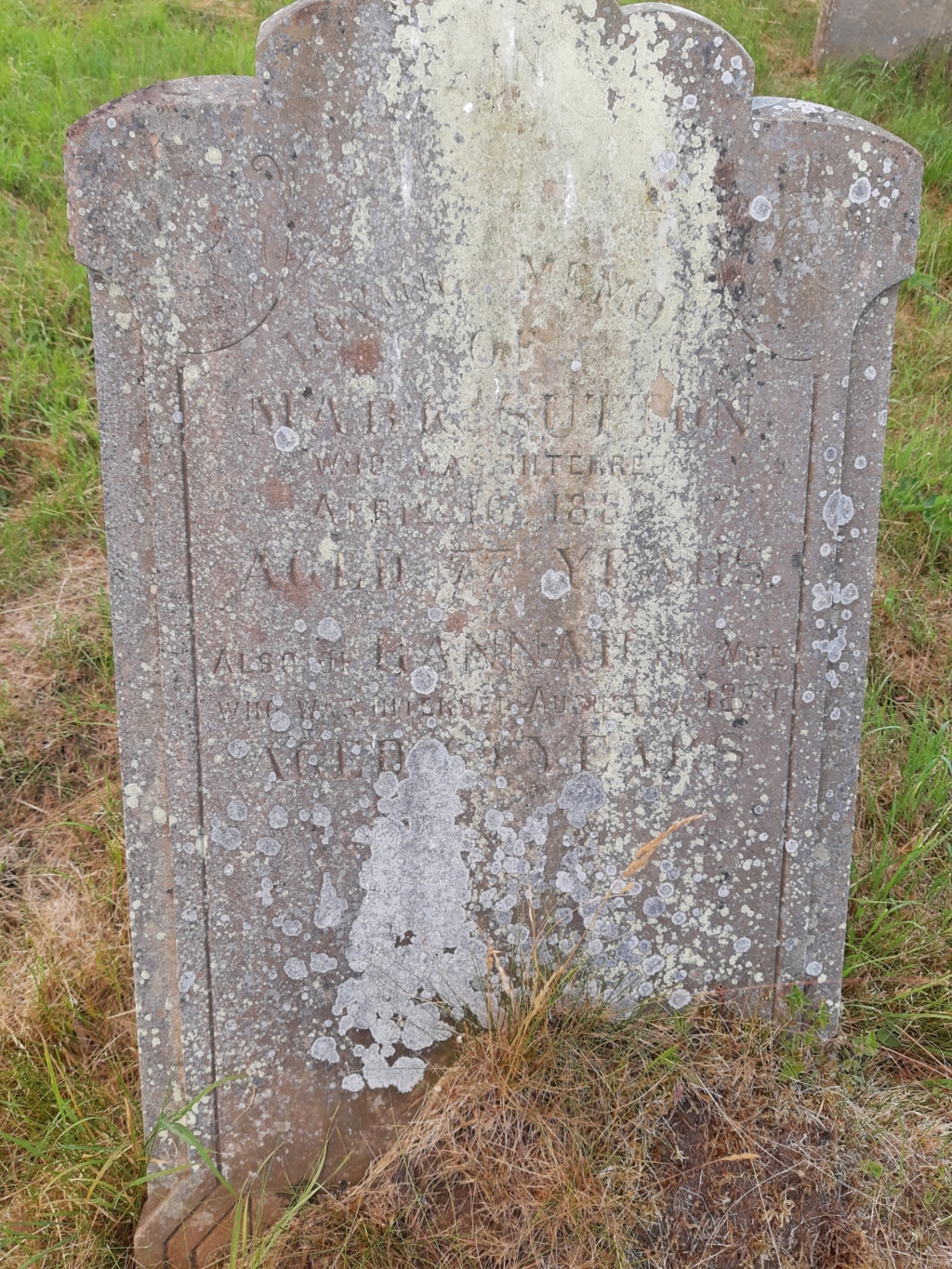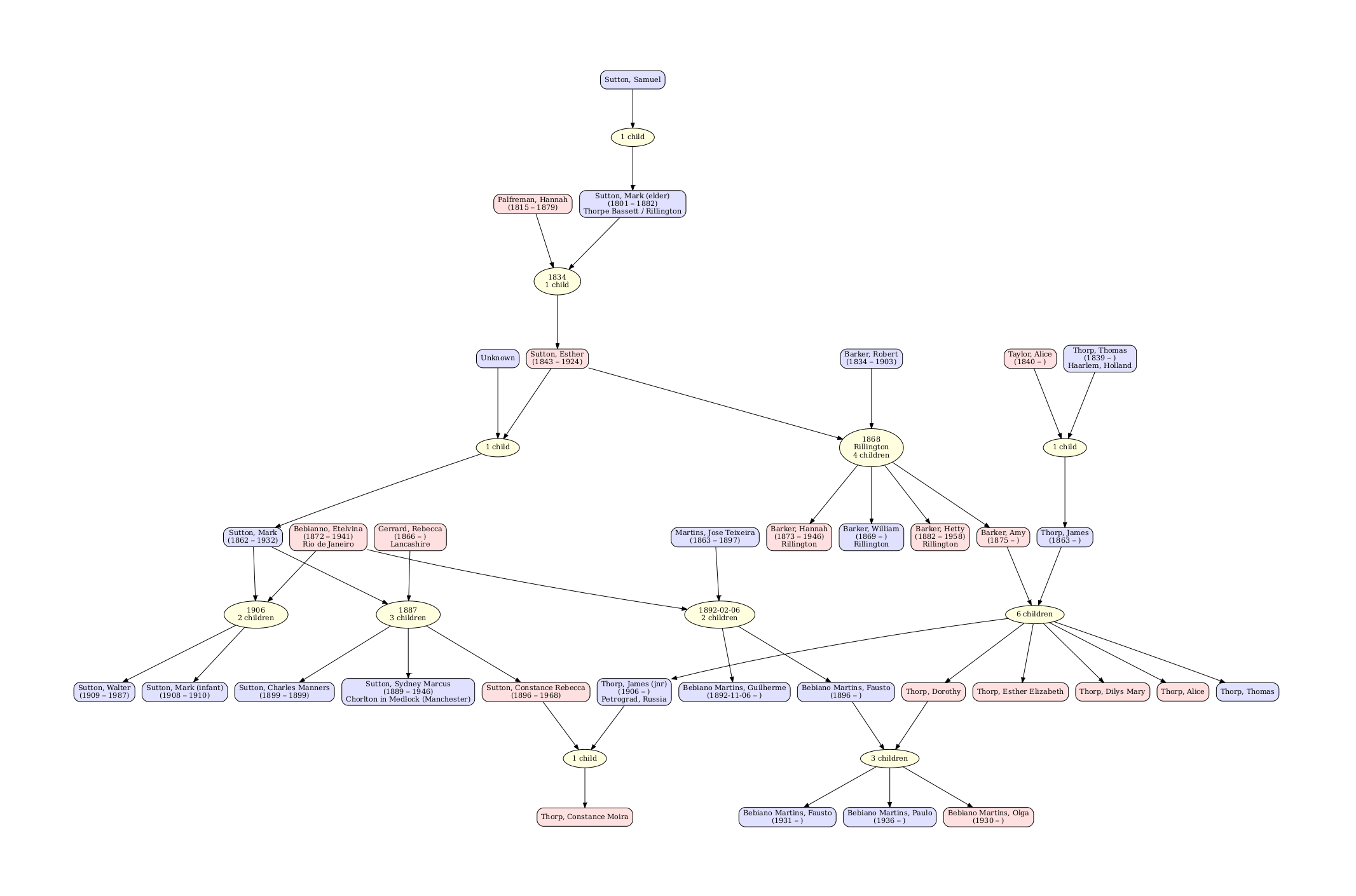Family Background
Mark Sutton senior, (grandfather of Mark Sutton), and Hannah Palfreeman his wife, were married at St. Olave’s in York on 15th November 1834. They both sign their own names. Mark senior was from Thorpe Bassett, Hannah came from Angram. Mark senior worked as a shepherd on various Rillington farms. In 1843 they had twins; Esther and George, baptised on April 22nd. 1843. George died soon after birth. He was buried on October 22 1843. The census of 1841 and of 1851 shows the Suttons living on Westgate. There are at least two records of Mark senior being taken to court for poaching and stealing firewood from the Scampston estate.
In the census of 1861 Hannah Sutton and her younger daughter, Ann are still in Westgate. They are boarding Elizabeth Bulmer, described as ‘Domestic servant’s child, blind.’ Mark Sutton (senior) is working on a farm down Low Moorgate.
Esther was discovered in Manchester boarding with her older, unmarried sister, Sarah (a dressmaker). She is working as a porter! She was difficult to trace as her name was recorded as ‘Hester’ and her Rillington birthplace recorded as ‘Billington’! Sometime during 1861 or early 1862 she becomes pregnant and returns to Rillington (although the order of these events cannot be established!).
Her first child, Mark Sutton was baptised on December 10th 1862 in Rillington church, son of Esther Sutton, spinster.
In 1865 she gives birth to Thomas Ruston Sutton while still unmarried.
In 1868 Esther marries Robert Barker, an agricultural labourer.
At the 1871 census they were all living apart; Mark Sutton (age 8) was with his grandmother, Hannah Sutton, in Low Moorgate and Tom (Thomas Ruston) Sutton, age 6.
Esther, now Esther Barker, was living as a lodger and charwoman at the home of Nicholas Stephenson, farmer of Low Moorgate and his sons and business partners Robert and Christopher Stephenson. Esther has had another child, William Barker, age 1 who is with her at the Stephenson’s farm.
Robert Barker is on his own at yet another Low Moorgate address.
Esther and Robert produce three further daughters; Hester, Hannah and Amy. They (and William) move to Providence Row.
Education and early working life.
In 1874 a School Board is formed in Rillington in response to the Education act of 1870 which encouraged the provision of non-sectarian education and the passing of by-laws to make education compulsory in local areas. There was no law making education compulsory on a national level until 1880. Rillington Board school was built in 1875 (ref. Bulmer’s directory 1892).
Mark Sutton, Esther’s eldest, illegitimate son, would later claim a board school education but he would have been 13 when the school was built. There was a church school in Rillington before the board school; maybe he attended that for some of his schooling.
In his later proposal for admission as a full member of the Institute of Mechanical Engineers Mark claims an apprenticeship with Joseph Simpkin, Millwright, of Rillington from 1878 to 1883. In the 1881 census he is found in Cayton and described as ‘farm servant indoors’. It may be that he did other work during this period or that he is out contracting for Simpkin.
By the 1881 census Esther and Robert Barker, their son William (11) and daughter Hannah (8) are living together in Providence Row.
In 1883 Mark moves to Manchester. According to his attestation to the IMech.E he worked as a journeyman between 1883 and 1889 for companies including Messrs. Hetherington andCo., The Manchester Gas Company and J. J.Sale and Co.
He also attends the Manchester Technical School. This had been set up by the Mechanics’ Institute to provide an education to working class boys with a new building inaugurated in 1856. It has struggled to enrol sufficient students once the new Board Schools provided an elementary education to everyone until J.H.Reynolds, a bootmaker who owed his own education to night school, became secretary in 1879. He encouraged part time education for young men in work and also encouraged participation in City and Guilds qualifications.
On April 7th 1887 Mark Sutton married Rebecca Gerrard at the Methodist church in Morcambe. She is the daughter of a fisherman, (subsequently a pilot) and was born in Morecambe. In 1889 she give birth to their first child, Sydney Marcus, in Chorlton-in-Medlock, Manchester. 1889 was also the year that Mark was first sent to Rio de Janeiro by Scott and Hodgson of Guide Bridge, Manchester ‘to take charge of a large concern’.
Scott and Hodgson was a manufacturer of stationary steam engines. They had also demonstrated their first diesel engine in 1901. It appears that Mark Sutton’s speciality is the large scale provision of power to factories. He will, initially, apply his skills to the booming cotton spinning industry in Rio.
A brief digression on cotton, colonialism, money and technology!
Cotton grows wild in Brazil and the fibres have long been used there. Under Portuguese rule mechanised production of cotton yarn and fabric had been banned in Brazil, only hand spinning was allowed. Similarly, in Britain, it was illegal to import cotton cloth from India. These measures were intended to protect the industrial base of the colonial powers. Places like America, India and Brazil grew the cotton (often with slave labour) and the Western countries imported it and turned it into more valuable yarn and cloth. Manchester, often known as ‘Cottonopolis’ had a huge cotton spinning industry and went on to become an important trading hub. Brazilian cotton was particularly popular in Manchester as it had a long staple. Not surprisingly, much of the innovation in spinning and weaving technology and also power generation happened in Britain and Manchester was at the forefront.
However, the world was changing. The Portuguese colonial presence in Brazil ended in 1822 and Brazilians were free to develop their own industry. The American Civil War in the 1860s had an impact on the ability of North America to grow and export its own cotton and Brazil with its supply of quality fibre suddenly had an economic advantage. If Brazil had the will and the money to build its own industrial base, Manchester could supply the skills, machinery and knowhow. Mark Sutton was an example of a new generation of practical engineers with practical skills, hands-on experience and a technical education.
Going up in the world!
In 1895 Mark and Rebecca have a daughter, Constance Rebecca, in Rillington. She and her older brother, Sydney Marcus, are both baptised in Rillington on 23rd. January 1896. In the baptismal register their abode is given as Rio de Janeiro and Mark Sutton is described as a mechanical engineer. It appears that they have given up their home in Manchester and Rebecca has been despatched to stay with her in-laws for her confinement. There is a note in the register that the conditional form of baptism is used by the mother’s request.
It appears that they then return to Rio but in 1899 Rebecca and the children are back in Rillington, living with Robert and Esther Barker, Mark’s mother and step-father, and her daughter Hetty. Rebecca is to be confined again and in August she gives birth to Charles Manners Sutton. Sadly he only lives 15 days and is buried in Rillington churchyard on September 5th 1899. He has a monumental inscription recorded in the green book but the stone has vanished.
It seems to be after this tragedy that Rebecca briefly takes to drink. She engages William Arthur Calam, a local bricklayer and musician to give music lessons to the teenage Sydney Marcus. Rebecca, whether lonely and grieving or truculent and resentful, develops a friendship with William Arthur Calam right under the unsympathetic eye of her in-laws. Mark Sutton sues for divorce, Hetty, Esther and Robert Barker enthusiastically gives evidence that involves long, late visits from Mr Calam. All three claim to have remonstrated with Rebecca and William Arthur and Mr Barker has tried to ban Mr Calam from the house. Rebecca, perhaps aware her behaviour is being monitored though keyholes, tosses her head and announces his visits are no-one else’s business. She (though described as a ‘stately lady’in court papers) doesn’t go down well with the court, the divorce is granted and costs are awarded against Arthur Calam. By 1911 Rebecca has returned to Lancashire to live with her brother, Richard Gerrard, a draper leaving her surviving children in the care of her husband.
Note: At the time of the events leading to the divorce the Barkers (and the reluctant Rebecca) are believed to have been living at Howard View in Low Moorgate, the top end just next to the church.
A new century, a new start!
The first decade of the twentieth century is a busy one for Mark Sutton. In 1905 he is approved as associate member of Institute of Mechanical Engineers. Then on the first of May 1906 he marries Etelvina Bebianno in Rio. She is the daughter of Domingo Alves Bebianno who has become a close business associate of Mark and was the widow of Jose Teixeira Martins and already has two sons; Fausto Bebianno Martins and Guillerme Bebianno Martins.
Mark Sutton is advancing both his social and fiscal status. In 1907 he buys a lot of real estate in Rillington including the farm a t 2, Westgate tenanted by the Ryders, Park farm and various cottages. He will buy Beechwood House, set up his mother, now Esther Barker and his half sisters, Hetty and Hannah there. It will be his pied a terre in the UK. It has a tower bult either by Mark or his predecessor. It is now demolished.
In 1907 Mark and Etelvina have their first child together. This time Mark does not feel the need to send his wife to Rillington. The third Mark Sutton is born in Rio Sadly he will die in 1910, age 2. They do have a further child together. On the 7th of November 1908 Walter Sutton is born, also in Rio.
In 1909 Mark Sutton is approved as full member of Institute of Mechanical Engineers. Below is a copy of his attestation detailing his achievements!

The attestation mentions that he is now a managing director of Cia America Fabril, a large and growing cotton manufacturing company. In 1911 he builds a cotton mill in Rio for them, housing 642 looms and 26,000 spindles powered by electronically-driven motors. Mark is associated with cotton mills at Mavilis and Carioca.
In 1912 Mark Sutton, along with Domingo Bebianno and a Scottish engineer, George White, founds ‘White Martins’, which becomes the largest South American industrial gases company.

Family and Community .
Meanwhile, back in Rillington in 1911, the widowed Esther Barker is living in Beechwood House, Rillington, with her daughters, Hetty and Hannah. At the time of the census Sydney Marcus Sutton, now 22 and an engineering student normally domiciled in Edinburgh, is staying with them. Constance Rebecca is discovered studying at Cheltenham Ladies' College in company with Angelina and Aida Bebianno.
During the 1920s Mark and his family travel (first class) between Rio and England quite frequently. In 1921 Mark Sutton, is found at the Midland Hotel in Manchester with a Brazilian wife, Etelvina B. Sutton and Constance Rebecca. All claim Rio as their usual place of abode.
In Rillington Esther, Hannah and Hetty are still at Beechwood House along with a 12 year old Walter Sutton, born in Rio, and a Portuguese servant, Mafalda Gomes, who is recorded as being in the employ of Mark Sutton.
Also in 1921 Mark sells the farm at 2, Westgate, Rillington to the tenant, Mark Ryder. Mark Sutton maintains his interest in the village, making large charitable contributions ar Christmas. In 1923 he gave £47 to the poor of Rillington, according to the internet it would have had the purchasing power of about £3000 today. He also gave £2.00 for the coal and clothing fund and a contribution of £100 towards a new hall for the WI. It is odd then that when his mother, Esther Barker, dies in 1924 aged 80, the Parish Magazine offers condolences only to her two daughters, ‘the mainstay of her old age’!
In 1932 Mark Sutton dies in Rio leaving Etelvina a widow She dies on the 4th of December, 1941. The Rillington Parish Magazine offers condolences to Hetty Barker without mentioning the exact relationship between them. It does briefly mention his record of generosity to the village. The same year Constance leavs England for Rio. She goes home to marry James Thorp on the 12th of December 1932. James is the son of James Thorp senior; a Salford engineer turned Anglsey hotelier. James Senior is married to Esther Sutton-Barker’s sister, Amy who thus becomes Constance’s mother-in-law as well as her aunt!!
Constance and James will travel between Rio and Rillington many times, importing a large car each time for the duration of their stay.
Fausto, the son of Constance’s step-mother Etelvina’s first marriage, will marry Dorothy Thorp, sister of Constance’s husband, James Thorp.
Constance will die in 1968 in Rio.
Sydney Marcus and Walter both marry and continue their lives in Brazil. Sydney Marcus dies in 1946, Walter lives until 1987.
Hetty Barker carries on living at Beechwood House. She is a member of the PCC and gives talks to the WI on such subjects as ‘Making Mats out of Binder Twine’. On the 1939 register she is living at Beechwood with Annie Berrimans, a domestic servant and at least one young girl, possibly an evacuee. She dies in 1958 aged 76 and is buried in the cemetery extension on February 13th. An Amy Thorp is also buried in Rillington, described as ‘our mother’. She turns out to be the daughter of Esther and Robert Barker, half sister of Mark Sutton and also mother-in-law to his daughter, Constance Rebecca. I’m still working this one out!( She married a James Thorp in Manchester, a millwright then boarding house keeper, was mother of another James Thorp who married Constance). The Thorps have connections in Holland and Russia!
As for William Arthur Calam, co-respondent in the divorce, he worked as a builder, stonemason and monumental mason in Rillington. He married Florence Dent, (spinster, illegitimate) on April 4th 1914. and they took up residence at ‘Orival’ on Malton Road. They had one daughter, William Arthur died on July 19th 1933 and his wife and daughter moved away.
Divorce


Transcript
THE LAW COURTS.
THE RILLINGTON DIVORCE CASE; A DECREE NISI GRANTED.
The hearing of the case of Sutton v. Sutton and Calam was resumed yesterday in the Divorce Court before the president, Sir Gorrell Barnes and a special jury. The petitioner, Mr Mark Sutton, a mining engineer of Rio de Janeiro sought for a dissolution of his marriage with the respondent, Mrs Rebecca Sutton on the ground of her alleged misconduct with the co-respondent, Mr Arthur Calam at Rillington, Yorkshire. Answers were filed denying the petitioner’s allegations. The case had been adjourned from Friday last. Additional evidence was now given in support of the petitioner’s case.
Hetty Barker said that when Mrs Sutton was living at her mother’s house at Rillington from 1899(?) to 1901 she had seen Mrs Sutton under the influence of drink. The co-respondent, Mr Calam, came to the house to give music lessons to the son. Witness had found the respondent and co-respondent alone in the sitting room and on one occasion Mr Calam turned the lamp down and witness left the room.
Other witnesses also gave evidence in support of petitioner’s case.
For the defence the respondent, Mrs Sutton, was called. She said that she left her husband in Brazil in 1899 to come to England to be confined and she went to live at Rillington at the home of her husband’s mother, Mrs Barker. She unfortunately gave way to drink, but had afterwards given it up. She engaged the co-respondent to give lessons to her son and he came to the house for that purpose. She denied the truth of the allegations which had been made. She would swear that on the occasion when the lamp was turned down Calam did not kiss her. She had met Mr Calam once in Huddersfield and they had tea together. She admitted that she and Calam had exchanged presents.
Mr William Arthur Calam, the co-respondent, said that he was a bricklayer and a musician. He bore out the evidence of the respondent as to giving music lessons to the son. He denied that he had ever committed adultery with Mrs Sutton.
The jury found that the respondent and co-respondent had committed adultery.
The president granted the petitioner a decree nisi with costs against the co-respondent.
Church Benefactor

Facsimile
The Yorkshire Post, Wednesday, July 26, 1905
Court orders
Download original_32f576b6-ffed-4818-93d3-0b30fb420e24_IMG_20220706_115135
Gravestone

![]()
Family tree
Download Sutton_familylines_graph


